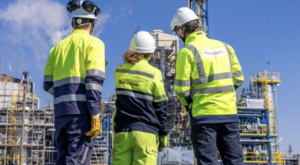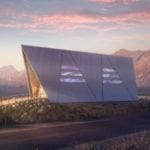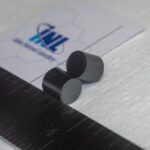In an exclusive interview, executives from Silicon Valley–based Oklo, a company Idaho National Laboratory (INL) chose this week to demonstrate the first-of-its-kind use of recycled high-assay, low-enriched uranium (HALEU) fuel in its full-size Aurora micro-reactor, told POWER that the project could have broad implications for the future of nuclear power.
Marking a significant boost for advanced nuclear innovation, which industry experts are banking on to transform nuclear’s future role in a rapidly changing power sector, INL on Feb. 19 said that it will give the developer access to processed and treated used fuel recovered from the now-decommissioned Experimental Breeder Reactor-II (EBR-II) for use in the demonstration of its 1.5-MW fast reactor.
The fuel, which will be downblended to a uranium enrichment of less than 20%—into high-assay, low-enriched uranium (HALEU)—will still be owned by the Department of Energy (DOE), and stay at INL’s site in Idaho Falls, Idaho, where Oklo last year received a first-of-its-kind site use permit to build its Aurora plant.
According to INL, while finalization of the opportunity announced on Wednesday still depends on striking a cooperative agreement with Oklo on the use of the HALEU material for the micro-reactor demonstration, the selection is a big step that markedly furthers its goal to accelerate deployment of commercially viable micro-reactors. As Dr. John Wagner, associate laboratory director for INL’s Nuclear Science & Technology directorate, noted on Wednesday, the benefit of using nuclear fuels with higher levels of U-235 is that it allows reactors to operate for years without having to be refueled. “That is an important attribute since this technology is envisioned to be used in remote areas that can be difficult to access.”
What is HALEU?High-assay, low-enriched uranium (HALEU) is nuclear fuel that is enriched to a higher degree (of between 5% and 20%) in the fissile isotope U-235. In comparison, the world’s current fleet of light water reactors (LWRs) typically uses fuel enriched to less than 5% U-235. As experts note, HALEU promises to provide more power per volume than conventional reactors, and its efficiency allows for smaller plant sizes. It also promises longer core life and a higher burn-up rate of nuclear waste. According to the Nuclear Energy Institute (NEI), many advanced reactor concepts—including some micro-reactors (many smaller than 10 MW), high temperature gas reactors in the 100-MW to 200-MW range, and salt reactors—may require this type of fuel. HALEU could also be used in existing light water reactors. Though NEI suggests annual commercial requirements for HALEU could soar to a cumulative 185.5 metric tons annually, there is no current supply of HALEU. But because establishing a commercial supply of HALEU would require sufficient demand and a minimum of 7 years to develop fuel cycle infrastructure, the industry trade group has urged the DOE for years to tap into its access of high-enriched uranium and downblend it in the interim to supply HALEU for demonstration purposes. The DOE has heeded these calls and recently ramped up efforts to establish HALEU fuel production capability, noting that in the near future, it will be critical to U.S. leadership, as global competition heats up to design and build small modular reactors as well as larger non-LWR reactors. |
A Major Milestone for Oklo—and Advanced Nuclear, Generally
Oklo, a company founded in 2013, is named for a Gabonese region known for its naturally occurring deposits of fissile U-235. The company launched the concept of its Aurora design in December, describing it as a “fission battery” which uses metallic fuel and can produce both heat and power. The concept was inspired by a NASA image that showed aurorae on earth from space. “We were inspired to see how both the beauty of the earth and current human energy needs, as well as human potential and the beauty of space, could be symbolized by the aurora dividing the lights on the earth from the lights from the stars. We are excited to think about how fission could both enable human development while preserving the environment on earth, and even enable deeper space exploration,” said Caroline Cochran, chief operating officer and co-founder of Oklo.
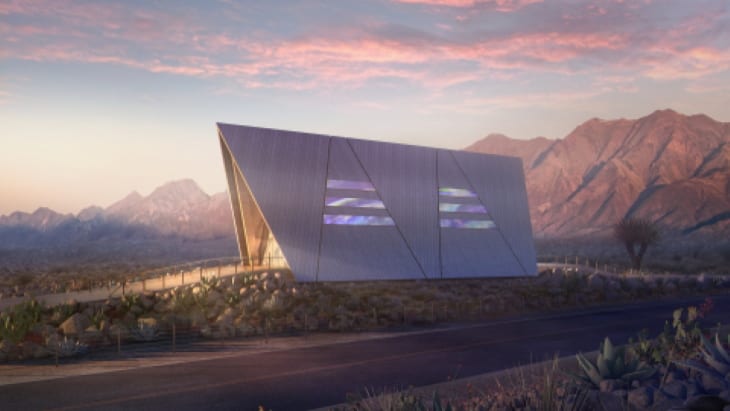
Jacob DeWitte, Oklo co-founder and CEO, recently told POWER in an exclusive interview on Feb. 17 that the company, which has been engaged in pre-application activities with the Nuclear Regulatory Commission (NRC) since 2016 for the Aurora design, will be submitting a license application in the coming week. “We’re looking at a review time schedule that is in the order of two years, possibly even better than that.” As to when the demonstration at INL could begin, he said Oklo is not ready to be specific yet. “Generally speaking, the time range of 2022 and 2024 is where we’re looking at, somewhere in that range.”
As DeWitte also noted, when Oklo submits the license application submission to the NRC, it will be for the nation’s first civilian effort geared to a micro-reactor and non-water reactor. Getting the first site use permit from INL and having the opportunity to work with the HALEU is already “a pretty big step to lining up all the key pieces to be able to demonstrate something in the very early 2020s,” he said.
A Giant Step for HALEU Production
The selection is equally a major step for the DOE’s efforts to bridge a major gap in HALEU production, which it says is imperative to propel interest and bolster development of advanced nuclear reactor designs. It comes amid a series of other notable recent steps the agency has taken to fast-track commercial HALEU production.
In January 2019, Dan Brouillette, who was then deputy secretary of energy and is now U.S. energy secretary, announced that the DOE was looking to demonstrate HALEU production by October 2020 in a first-of-its-kind $115 million project at the agency’s American Centrifuge Plant, a uranium enrichment facility in Piketon, Ohio. Last November, the DOE formally signed a three-year contract with Centrus Energy to deploy a cascade of centrifuges to demonstrate the advanced nuclear fuel. Under the contract, Centrus will license, build, assemble, and operate AC100M centrifuge machines and related infrastructure in a cascade formation to produce HALEU. DOE documents, however, suggest that while construction could begin this year to balance the centrifuges, the project will likely be wrapped up in September 2021, even though the contract runs through 2022.
Last week, meanwhile, the DOE’s National Nuclear Security Administration (NNSA) awarded an initial $3.6 million contract to BWX Technologies’ (BWXT’s) subsidiary BWXT Nuclear Operations Group to decommission some parts and refurbish other parts of its Lynchburg, Virginia, facility and get it ready to produce uranium-molybdenum alloy High-Assay Low-Enriched Uranium (U-Mo HALEU) as soon as 2024. The fuel is to be used in federally run U.S. research reactors, which are currently fueled by high-enriched uranium (HEU). BWXT says that it has been working on its own as well as with the NNSA since 2006 to develop the U-Mo HALEU fuel, which is “designed to retain the reactors’ performance while lowering the proliferation risk.”
By the end of the year, meanwhile, BWXT, is also preparing to restart production of its line of TRi-structural ISOtropic (TRISO) particle nuclear fuel—a type of HALEU fuel that consists of a very small kernel of uranium coated with a variety of silicon- and carbon-based materials, and is designed to withstand extreme heat with low proliferation concerns and environmental risks. BWXT told POWER its existing TRISO production capability will position the company to meet emerging demand from Department of Defense micro-reactors; NASA, for nuclear thermal propulsion requirements; and civil advanced reactors. Ramping up production capacity to meet demand is a priority, it suggested. The company also noted that it currently has the only private Category 1 licenses in the U.S., and they can also be used to produce Category 2 material, which HALEU requires, but “can take several years and substantial investment to obtain.”
INL’s Small-Batch HALEU Process
Until a commercial HALEU market is established—which will require that more advanced nuclear reactors clear demonstration and ultimately come online—INL will lead efforts to provide the fuel for research and demonstration. For now, it plans to provide HALEU for Oklo through the recovery and treatment of HEU from used fuel from the 19-MWe EBRII (a demonstration reactor, that operated from 1963 to 1994) that was previously being treated and processed for disposal.
The process to down-blend the HEU to HALEU involves a three-step electrometallurgical treatment. First, the irradiated fuel is prepared and placed into a molten salt electrorefiner, which facilitates recovery of uranium metal from fission products and transuranics. Then, the recovered uranium undergoes vacuum distillation to remove electrorefiner salt and is down blended to an enrichment of less than 20% U-235. Finally, the recovered uranium metal is configured to support fuel fabrication by reheating and casting it into low-dose, reduced-size HALEU “regulus.”

The process will allow INL to produce up to 10 metric tons of HALEU for research, development, and demonstration purposes. Even the “fraction” Oklo could receive would be more than enough to power the demonstration for 20 years without needing a refuel, as Oklo COO Cochran told POWER. DeWitte added that Oklo wants to build the demonstration as a full-scale Aurora unit and run it through its full lifetime to get as much data as possible and experience that will prove crucial to future units. “Yet, from a purely technical perspective, five times greater than 20 years is possibly achievable,” he said.
The process also leaves INL with enough HALEU for entities developing other advanced nuclear reactors backed by the lab’s newly established National Reactor Innovation Center—a hub for testing, demonstration, and performance assessment whose main aim is to accelerate deployment of advanced nuclear technology concepts. As INL’s Dr. Wagner added on Wednesday, INL is continuing discussions with other applicants to see how the lab can support their efforts.
But while INL told POWER on Wednesday that “[o]ther sources of HALEU are available to support R&D demonstrations and would be made available as needed,” it is unclear if the lab will continue to pursue other methods to produce HALEU. INL documents dated as recently as June 2019 suggest that the lab planned to back advanced reactors testing through installation of a full-pilot scale plant that uses a ZIRCEX (zirconium extraction) process, which essentially removes zirconium or aluminum cladding from nuclear fuel and then purifies uranium from fission products using a “very compact, modular solvent extraction system.” The uranium is then down-blended to below 20% before solidification and fuel fabrication. For now, the ZIRCEX program appears to still be in the research phase.
Meanwhile, though it is proving crucial to commercialization of SMRs and other advanced nuclear technology, funding for INL’s future research initiatives also remains a question. While the DOE’s authorized fiscal year 2020 budget includes funding that supports processing the EBR-II used fuel, future funding is subject to Congressional authorization. The DOE’s latest budget proposal, notably, dramatically slashes funding for its Advanced Reactors Demonstration Program, and nearly halves funding for fuel cycle R&D.
A Significant Paradigm Shift for Nuclear
Finally, and perhaps most critically, the selection’s most significant impact may be on two pain points that have crippled nuclear sector growth for decades: construction of new reactors and disposal of nuclear waste.
Oklo’s plan to build a full-size demonstration is a significantly different “paradigm shift” from conventional approaches, which have frequently proved exorbitantly expensive and ridden with insurmountable challenges, DeWitte noted. The project is infinitely smaller than conventional reactor projects—its INL site will span less than a quarter acre. Still, “You need to have certain economic conditions in place to feel comfortable with the investment, given the amount of capital needed to do that,” he said.
“Starting very small allows us to be a lot leaner and a lot nimbler in terms of the business model, and that’s a really important aspect. Being a venture-funded company, we’re able to do things on a very quick timescale, but also access capital that allows us to do things like build a first-of-a-kind reactor that we can learn from, but also helps us be … kind of like a showroom floor model. There’s a lot of value in that for the commercial applications,” he said.
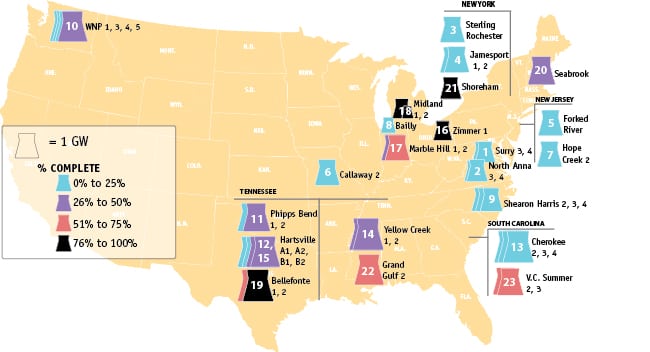
Another interesting aspect about this announcement “is that it shows you can actually reuse [spent nuclear fuel (SNF)],” DeWitte noted. That aspect is important because nuclear waste management in the U.S. has stalled for nearly three decades, owing largely to a political impasse on the disposal of SNF. Today, according to the NEI, more than 84,000 metric tons of SNF is temporarily being stored in pools and casks in 35 states.
In its latest budget request, the DOE suggested it would explore alternatives to the Congressionally mandated Yucca Mountain, but it provided few specifics. The budget, however, proposed $295 million to fund the experimental Versatile Test Reactor (VTR), a first-of-its-kind fast reactor (and another important project INL is spearheading) that could help the private sector develop and demonstrate new technologies.
The DOE has suggested the VTR, which will likely be a sodium-cooled pool type reactor that will use fuels with metallic alloys (including HALEU) could be operational by 2026, at a cost of between $3 billion and $6 billion to build. However, its focus on fast neutron systems is remarkable because, as POWER has reported, fast neutron reactor systems have the potential to extract 60 times more energy from uranium compared to existing thermal reactors, and they contribute to a significant reduction in the burden of radioactive waste. Interest in fast reactors worldwide has seen a surge of late; however, while technical advancements and operational experience has grown, technologies today still face technical, regulatory, and economical challenges.
But that’s yet another reason the first-of-its-kind Aurora demonstration will be important. DeWitte called the project’s novel use of HALEU a “loner’s journey in material,” but he underscored it is not insurmountable. The research opportunity could offer the developers considerable insight into issues that have been frequently cited as key hurdles, including licensing, the fuel cycle, and the larger fuel supply chain, he said. However, many aspects of the existing nuclear system, including infrastructure, licensing, and technology already cater to even more highly enriched fuels. “At the end of the day, it’s how [HALEU is] treated and viewed and managed,” he said. “The only reason that we put the ‘HA’ [which stands for ‘high-assay’] in front of the LEU [low-enriched uranium] is because today’s reactors don’t really use it, so there’s a delineation drawn, because of the considerations that come from that. It’s a little simplistic, but it’s LEU at the end of the day.”
Based on an Icon, Poised to be Iconic
Asked if Oklo anticipates any specific technical challenges using recycled fuel like HALEU, which may contain residual radionuclide components that some advanced reactors are unable to handle, DeWitte said that because Aurora is a fast reactor, it inherently harbors the ability to tolerate impurities and still operate efficiently. “Because this material has been irradiated for another reactor [EBR-II]—and that’s also exciting for us because [EBR-II] was a significant inspiration for us—it will still have trace contaminants, and even though [INL] will be able to clean it up quite a bit, some of those impurities still go through the process and down-blending. One of the aspects of having re-used uranium is that you also have a slightly different composition of U-235, U-234, and U-236 isotopes—those are very trace relatively, but they still exist. And in a reactor that uses slowed-down neutrons, or a thermal reactor, the impact of those as well as the other impurities is much more noticeable and significant, whereas in a fast reactor, they have almost no consequences,” he explained.
“It doesn’t affect the reactor operation side. Where there is an impact, though, is the fuel handling and fabrication side,” DeWitte said. Oklo has been working to understand the different material considerations, including what will be required in a commercial process to tackle it. “The good news is—though that’s not going to be how it will work here because we’re not using the same process—that EBRII already demonstrated this kind of advanced recycling approach. They were able to literally recycle the fuel from the reactor and then recast it with significant amounts of these materials present, as well as higher actinides and plutonium and other things, and they were able to fabricate it and put it back into the reactor. They were able to do it for 10s of thousands of fuel elements—which is pretty exciting from a long-term view perspective.” What will be important to the future of advanced nuclear is ensuring it has the right infrastructure in place to ensure industry has the right fuels, he said.
The Economic Case for Tiny Nuclear
Because of these uncertainties, which the demonstration is certain to shed more light on, DeWitte and Cochran both noted that the first Aurora unit won’t be markedly cost-effective compared to existing small-scale generating technologies. “But there’s other commercial value to it,” noted DeWitte. “And with the following units, we have a very strong and clear case with the economics of where we’re going to compete—and that’s mostly in off-grid and remote markets that are relying on diesel fuel to start.”
Foremost among the key economic considerations DeWitte cited is the energy density of HALEU. While the percentage of enriched fuel in HALEU for advanced reactors varies, “the smaller they get, the closer they get to a 19.75% range. We’re around that range but the exact number has yet to be made public,” he said. At the “very simple root of the answer” of why HALEU is suitable for advanced reactors is that they are able to “effectively use fuel for longer time periods,” and the fuel allows them to tap into that potential more readily. The existing light water fleet is increasingly adopting advanced fuel like accident tolerant fuel for the same reason, he noted.
“It’s really powerful when we think about the fact that we have fuel that’s going to be kind of more energy dense than the closest alternative,” DeWitte noted. “And the economic upside of that is that it will be the underpinning driver for why there’s this new wave of advanced reactor deployment, coupled, of course, with the broad economic benefits that come from that as well as the zero-emissions that would come from that.” Paired with the simplicity and inherent and passive safety that advanced designs like Aurora offer—including self-stabilization—that “enables you to do so much in the design space that really helps drive costs down,” he said.
Over the longer term, factoring in experience and generational development of its technology, Oklo is targeting a cost competitiveness of $0.05/kWh. “When you have a fuel source that gives you a multimillion dollar–fold competitive advantage, you sure better be able to be economically competitive,” DeWitte said. “And I think we have a pretty strong shot at doing that.”
—Sonal Patel is a POWER senior associate editor (@sonalcpatel, @POWERmagazine)






